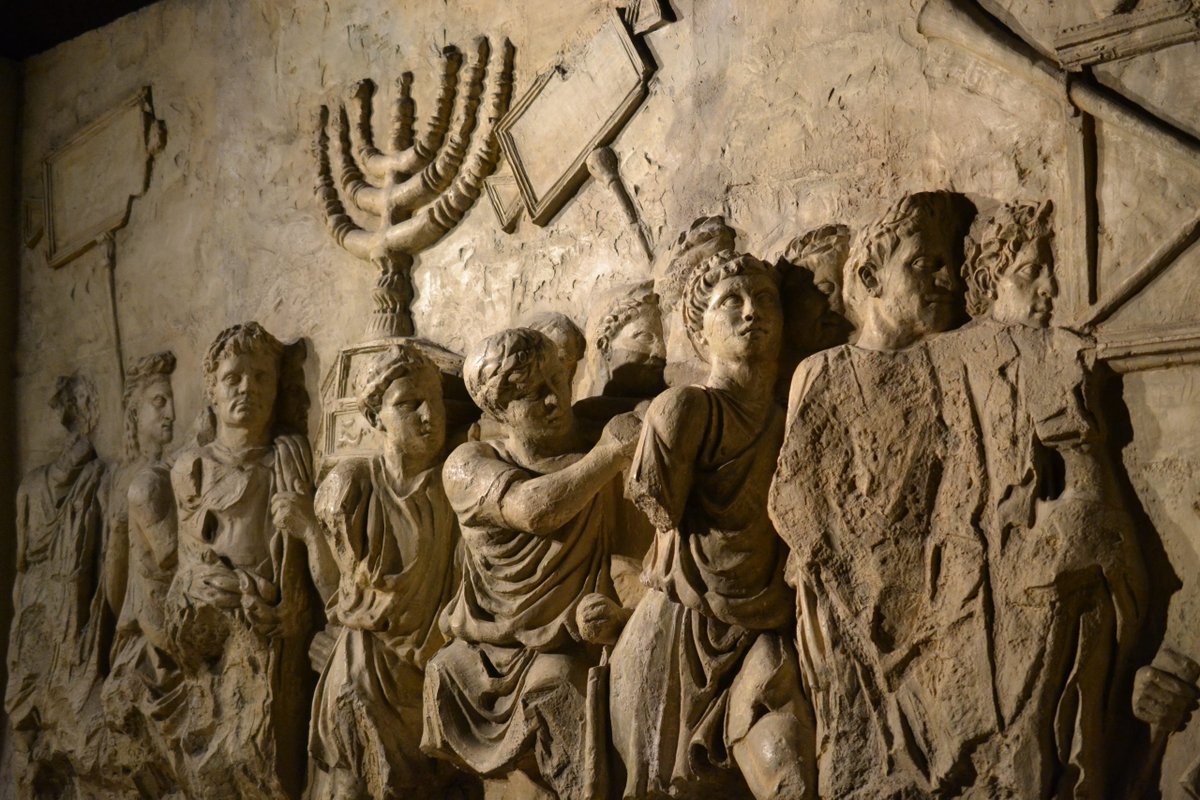
This thread by David Parnell, historian of the Roman Empire, and specialist on the time of Justinian in the sixth century AD touches on a subject I've read about before - what happened to the artifacts taken by the Romans from the Second Temple in Jerusalem after its sack and destruction in 70 AD and particularly the fate of the Temple Menorah.
The photo above is from the inside of the Arch of Titus, on the Sacred Way between the Forum and the Colosseum, erected in commemoration of the emperor's capture of the Jewish city. I've walked through it and seen the various artifacts raised in triumph.

As Parnell points out we know the Menorah was taken to Rome because of its portrayal on the Arch and the reference to it by the Jewish historian Josephus, who defected to the Roman thus surviving to write his histories of the Jewish revolt and broader story of the Jews. Josephus tells us the Menorah was present during the celebration of Roman victory and describes it
"the candlestick that was made of gold... its middle shaft was fixed upon a basis, and small branches were produced out of it to a great length, having the likeness of a trident in their position, and every one had a socket made of brass for a lamp at the tops of them."
The next relevant reference in literature to the Temple treasures is more than four centuries later, by the Byzantine historian Procopius, who was also private secretary to Justinian. Writing of the Byzantine conquest of the Vandal kingdom in North Africa in 533, he states that among the treasures sent from Carthage to Constantinople after the conquest "were the treasures of the Jews, which Titus, the son of Vespasian, together with certain others, had brought to Rome after the capture of Jerusalem." If the Menorah was among these treasures it would have been displayed during the Roman General Belisarius' triumph in Constantinople the following year.
How did those treasures get from Rome to Carthage? In 455, the Vandals, led by Geiseric, sacked Rome, and took an enormous amount of loot back to Carthage. Though not mentioned specifically in any contemporary chronicle it appears, based on Procopius, that the Temple artifacts were among the loot.
Procopius goes on to write that the Jews of Constantinople, seeing the temple artifacts, urged Justinian to send them back to Jerusalem. According to Procopius, the emperor agreed and "quickly sent everything to the sanctuaries of the Christians in Jerusalem." Though Justinian was hostile to the Jews, with Christianity now the religion of the empire and Jerusalem a pilgrimage site, he may have thought it appropriate to give the artifacts to the Christians there.
After that the artifacts disappear from history. What might have happened? In 614, the Persians, in the midst of the last great war of antiquity (602-28) conquered the Roman province of Palestine and we know they took Christian artifacts, including the True Cross, back to their lands in Mesopotamia. Though the Cross was returned at the end of the wars in 629, could the Jewish artifacts have remained with the Persians?
Also left unanswered is whether the Menorah was still among the "treasures" taken by Belisarius back to Constantinople in the sixth century. The gold of the Menorah would have been very valuable. Could it have been melted down by a Roman emperor to help finance the empire's costly wars? If so, the most likely time would have been during the reign of Marcus Aurelius (161-80). Serious barbarian incursions across the Danube during his reign placed the empire under great stress and it is reported that Marcus was reduced to auctioning furniture from his palace to help pay for the military. Might the Menorah have been destroyed at that time?
No comments:
Post a Comment